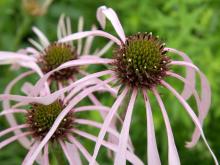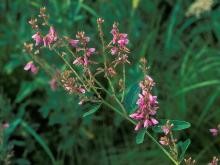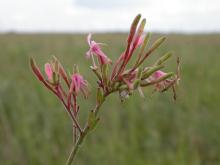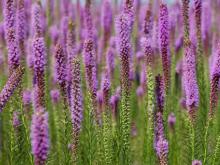Wildflowers, Grasses and Other Nonwoody Plants
Media

Species Types
Scientific Name
Echinacea pallida
Description
One of Missouri's five types of echinacea, pale purple coneflower is distinguished by its white pollen, drooping pink or purple ray flowers, and narrow, tapering leaves. It occurs nearly statewide, except for the Bootheel lowlands.
Media

Species Types
Scientific Name
Desmodium spp. (17 species in Missouri)
Description
Missouri has 17 species of tick trefoils, which live in a variety of habitats. Hikers know them well from their chains of hairy little seedpods that stick to clothing like parasites!
Media

Species Types
Scientific Name
Oenothera filiformis (formerly Gaura longiflora, G. biennis)
Description
Large-flowered gaura is a tall plant whose white flowers turn pinkish as they age. Four petals point upward, then bend back, and 8 stamens droop downward. The flowers look something like small butterflies.
Media

Species Types
Scientific Name
Dalea purpurea (formerly Petalostemon purpureum)
Description
Purple prairie clover is a legume of prairies, glades, and other open places. Its unusual flowering heads ringed with rose-magenta flowers and its attractive foliage add special interest in the home garden.
Media

Species Types
Scientific Name
Mimosa quadrivalvis (also Schrankia nuttallii)
Description
Sensitive briar is a dainty-looking legume with delicate, twice-compound leaves and flower heads resembling magenta pom-poms. The long, tough stems are covered with tiny thorns that snag your feet as you walk.
Media

Species Types
Scientific Name
Symphyotrichum oblongifolium (formerly Aster oblongifolius)
Description
Oblong-leaved, or aromatic aster, is well-named. It is notable for its fragrant foliage and its crowded, stalkless, clasping, hairy, narrow, oblong leaves. Like our other native asters, it blooms in late summer and fall.
Media
Species Types
Scientific Name
Erigeron philadelphicus
Description
The antique belief that this plant might repel fleas gives the fleabanes their name. There are more than 170 fleabanes in the genus Erigeron in North America. This one is scattered to common nearly throughout Missouri. Native Americans used this species medicinally for a variety of ailments.
Media

Species Types
Scientific Name
Liatris pycnostachya
Description
Prairie blazing star has an unbranched stalk with many densely crowded, rose-purple flowerheads. It is a signature wildflower of the tallgrass prairie.
Media

Species Types
Scientific Name
Lobelia cardinalis
Description
Cardinal flower provides a splash of bright red along streams and rivers, in bottomland forests, in ditches by roads, and in other wet places. It's a long-blooming Missouri native wildflower.
Media

Species Types
Scientific Name
Asclepias syriaca
Description
Common milkweed is famous as a food plant for monarch butterflies. It bears curious seedpods bearing seeds that fly on silky parachutes. It's common statewide in a variety of habitats.
See Also
About Wildflowers, Grasses and Other Nonwoody Plants in Missouri
A very simple way of thinking about the green world is to divide the vascular plants into two groups: woody and nonwoody (or herbaceous). But this is an artificial division; many plant families include some species that are woody and some that are not. The diversity of nonwoody vascular plants is staggering! Think of all the ferns, grasses, sedges, lilies, peas, sunflowers, nightshades, milkweeds, mustards, mints, and mallows — weeds and wildflowers — and many more!





















